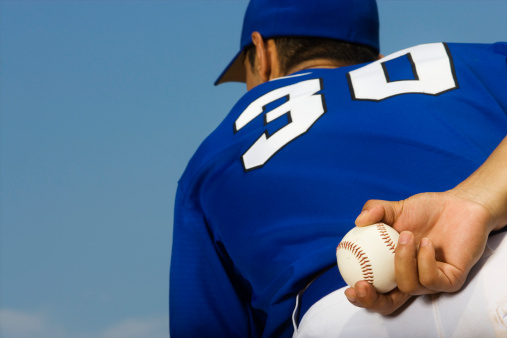
RISK FACTORS FOR ADOLESCENT PITCHERS
Research has shown that the amount of competitive pitching and pitching while fatigued are strongly linked to injury.Other risk factors may include pitching on multiple teams, pitching year-round, playing catcher when not pitching, poor pitching mechanics, and poor physical conditioning.
REDUCING RISK OF TOMMY JOHN INJURY
- Optimize pitching mechanics to ensure using the whole body in a coordinated sequence (kinetic chain). A biomechanical analysis is recommended, as it provides objective data to the pitching coach, strength coach, and pitcher. A biomechanical analysis can also serve as a baseline for re-evaluation later in the pitcher’s career, after performance improvement or after return from injury.
- Vary speeds for each of your pitch types. This will not only reduce the overuse on the elbow, but also can be an effective strategy. The best professional pitchers pitch with a range of ball velocity, good ball movement, good control, and consistent mechanics among their pitches. The professional pitcher’s objectives are to prevent baserunners and runs, not to light up the radar gun.
- Open communication between a pitcher and his professional coaching and medical staff is paramount. The pitcher’s elbow and body are living tissue. Pitching and training create small tears in the tissue; rest, nutrition, and hydration repair the tears. A pitcher and his team should have a plan, but that plan needs to be monitored and sometimes adjusted depending on how the pitcher feels. Specifically, the pitcher should keep his trainer or coach up to date about any soreness, stiffness, and pain. That way when there is an issue, the player and team can consider rest, modified activity, or examination from the team physician to allow the elbow to heal and avert serious injury.
- The pitching coach needs to watch for signs of fatigue on the mound. This could be seen in-game as well as in bullpen sessions.
- The team trainers, coaches, medical staff, and front office must share knowledge in a holistic approach to minimize the risk of injury.
- Flat-ground throwing drills and bullpen sessions should not always be at maximum effort. Reduced effort will allow for physical fitness and technique without adding undue stress to the UCL.
- Be wary of pitching in winter league baseball. The UCL and body need time to recover and build strength, so the concept of annual periodization should include adequate rest from full-effort pitching.
- Exercise, rest, and nutrition are vital for a pitcher’s health. Performance-Enhancing Drugs (PEDs) may enable the athlete to achieve disproportionately strong muscles that overwhelm the UCL and lead to injury.
- Pitchers with high ball velocity are at increased risk of injury. The higher the ball velocity, the more important to follow the guidelines above.
Information provided by the American Sports Medicine Institute
